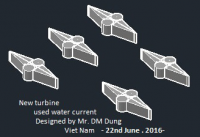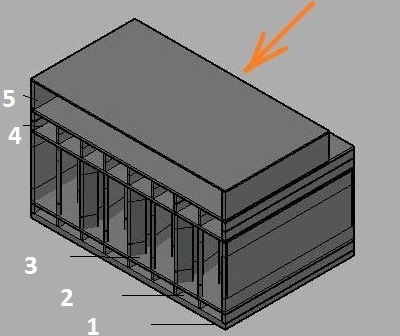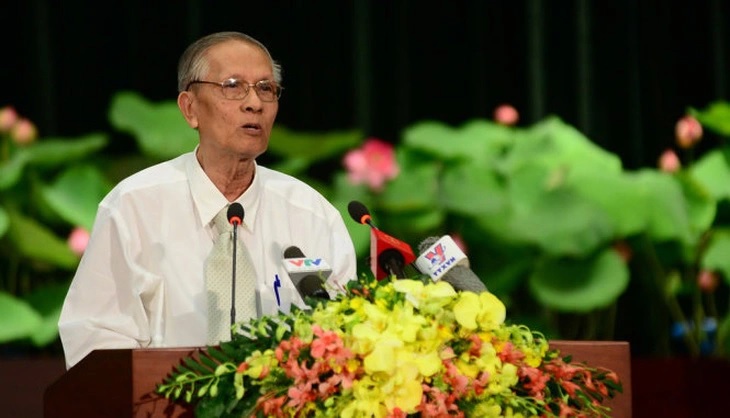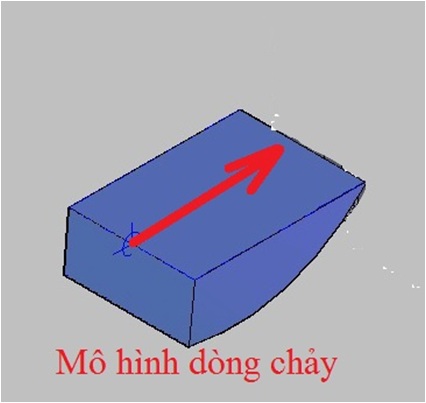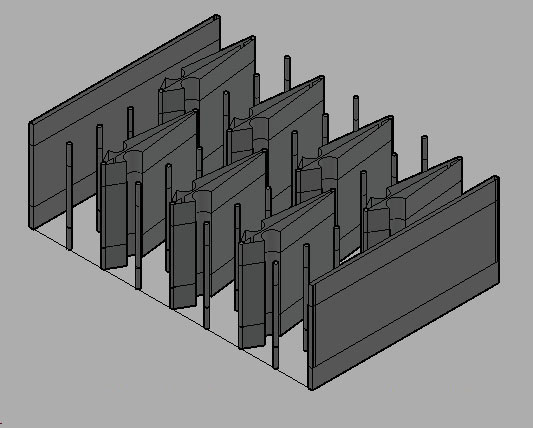New generator technology of Viet Nam by ocean currents and tail currents of hydroelectric dams
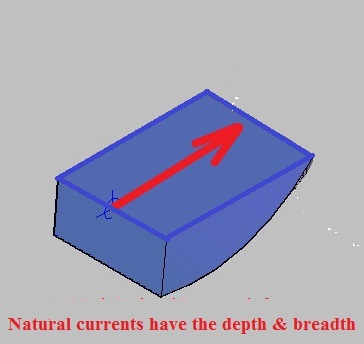
An ocean current is a block of water with a depth and width that moves in a direction parallel to the water surface. The speed of the currents near the surface of water is highest and decreases gradually when it reaches the bottom.
Hydrokinetic conversion systems will be highly effective if it has 6 factors as following :
1.1 Near the coast: Convenient to supply electricity to residents.
1.2 Shallow water area: Reduce costs when using the too deep water.
1.3 High-speed ocean currents: The machine converting from kinetic energy to electricity is highly efficient.
1.4 The ocean current has a stable direction: Low cost technology solution.
1.5 Wide ocean current: Convenient for industrial exploitation.
1.6 Long ocean current: Convenient for the formation of many industrial exploitation centers.
Other natural currents on earth such as rivers, tidal currents, and tail currents of hydroelectric powers have similar characteristics of ocean currents.
Figure 1: A blue ocean current with highest width, depth. Ocean current velocity near the water surface is highest and decreasing to the seabed.
2. Technology to exploit hydrokinetic energy in the world
Hydrokinetic energy is determined by the formula for the kinetic energy of a moving object.
E = 0.5 mvv
With the above formula, the energy source increases with the quadratic power of speed.
If the speed of water flow from 1m / s increases to 2m / s, the energy source increases 4 times.
The exploitation of wind power also bases on the above formula. Since water has a density of m than wind 830 times, even the small water speed also creates an enormous energy source.
With the river current, 1 m3 of river water when moving at the speed of 1m / s brings the energy source:
E = 0.5 x 1000 kg x 9.8 N x 1m / s x 1m / s = 4900 W
A worker with a capacity of 100 W, so the energy source of 1 m3 of water at a speed of 1m / s has the power of 49 people.
The problem with humans is, by which technology, is it to convert the kinetic energy of the water currents into electricity with optimum efficiency?
Today’s modern world, the people still uses traditional propeller system placed in water to get energy. This method has 4 disadvantages:
1/ Only the energy of the flow flowing through the propeller charge can be obtained.
2/ The weight of blade should be, so the bigger the machine, the blade is bigger, the weight of blade reduces the machine’s efficiency.
3/ Because of the weight of the blade, the machine is limited by the minimum water flow speed .
4/ When the machine converting from hydrokinetic energy to electric power is placed in water, it should be watertight, so the cost is high.

Figure 2: Blades are being used around the world to convert hydrokinetic energy into electricity.

Figure 2-1: Giant blade for ocean currents in the world .
The above shortcomings have prevented humans from developing ocren current electricity.
3. Resources of ocean hydrokinetic energy in Vietnam
3.1 The ocean currents at the water surface in central coastal Vietnam.
In the book “Situation of some Meteorological factors – Ocean in Vietnam and neighboring waters” of the Naval Command – in 1985, there is a full description of the phenomenon of floating objects along the central coast of Vietnam. with moving track and movement speed from page 62 to page 76. The tracks of floating buoy moving near the central coast in the direction from North to South in 8 months, including January, February, March, and 8.9. , 10,11,12. It was a time with northeast monsoons.
In navigation, seafarers know that when they sail from north to south, they should sail near the coast in order to speed up the ship. When they sail from South to North, it is necessary to sail offshore to avoid the sea currents of the North-South at the sea surface.
3.2 North-South bottom layer ocean current.
In the process of studying the port system on the East coast, the author has discovered the existence of the ocean current from North to South at bottom layer. When sunlight shines on the sea surface of the Equator, the surface waters expand, the bottom water rises upwards. The water from sea surface flows towards the North Pole and the bottom water of the North Pole moves towards the Equator. Since the earth turns from west to east, the bottom ocean current is oriented from northeast to southwest, while the surface ocean current has a southwest-northeast direction.
In the winter, the resonance between the sea surface currents and bottom currents has created a strong North-South current, suitable for industrial exploitation.
3.3 Truong Son Mountain has prevented the southwest monsoon
Dueto the Truong Son mountain has prevented the southwest monsoon, therefore the sea currents running along the central coast have less influence on the southwest monsoon and their main direction is from North to South.
3.4 Kinetisc accumulation of ocean currents in the central coast of Vietnam
Currents are caused by wind or by circulation moving from the North Pole to the Equator. While moving on, the earth’s radius increases as it has been approaching the Equator,hydrokinetic energy is accumulated, the velocity of sea current will increase proportion the latitude of the sea current reaching. Due to the coast of ASIA continent is deviated to the west when it forwards to Aquator , therefore the sea surface current and the bottom current are accumulated with enormous energy when it reachs at the Central coast of Viet Nam.
This is the special characteristic that the nature mother have rewarded to Vietnam.
In USA, Florida penisula has prevented the moving of sea current , therefore that sea current have been changed the form and lost the energy .
With the above analysis, the hydrokinetic energy at the central coast of Viet Nam is universe energy accumulating on moving of wind, sunlight and geographic shape of Asia cotinent ’s east coast.
3.5 The studying of world on west ocean currents of the Pacific by satellite
On the website www.elsevier.com/locate/renene , on page 737, the author Yu-Chia Chang, Peter C. Chu, Ruo- Shan Tseng wrote on January 8, 2014 and published on 2/2/2015 :
“The waters near Vietnam is most suitable for the development of current power generation”.
On page 743 published detailed data of 12 locations with the highest flow in the Western Pacific, of which Vietnam occupies 7 of the best positions, then Japan has 3 positions, Taiwan has 1 positionand the Philippines has 1 position. All 7 locations of Vietnam are on the central coast of Vietnam. The highest speed is 1.26 m / s, the lowest speed is 1.05 m / s.

Table with the coordinates and velocity of sea currents in the West Pacific coast written by the USA and Taiwan experts.

Thus, the world’s research is the same studying of Ks Doan Manh Dung and KS Doan Thanh Tung completed at the end of 2014 by theoretical mechanical method and experiment.
4. The new generator technology of Vietnam for ocean currents
Any resource can be found very early. But to be able to use them humans need technology. Humans often use solutions that copies as the nature as . With hydrokinetic electricity technology, the author had to completely use theory and solve the problem step by step with theory.
When studying the optimal rotation in water, it is a cylinder that rotates around its own axis.
If the cylinder has an empty place in side so it can receive the Archimedes force that be come as ideal top as due to the weight of it has been rid.

Figure 3: Structure of the Doan blade
In order to rotate a cylinder in water, it is necessary to cover a half of the cylinder body to convert the hydrokinetic energy into the torque of rotation.
The cylindrical body has blades that receive the appropriate force from the flow.
With the above model, the machine has a vertical axis, the blade is in the water, the generator part is above the water surface.

Figure 4-1 The first experiment machine- horizontal view.
Figure 4: The first experiment machine -View from above
The rotating drum is a bicycle wheel that has been filled with air. When there is no air, the wheel cannot float, the drum can not rotate. Power generation system is located on the water.

Figure 5-1 The second experimental machine – diagram of rotating drum arrangement.

Figure 5-2 The second experimental machine- view from the above.

Figure 5: The second experimental machine – photo taken from the outside
The machine includes 2 drums. Water flows between 2 drums. The 2 drums rotate in opposite directions.
The rotating drum is made of iron, with a diameter of 27 cm and a depth of 52 cm. The first drum weighs 4.6 kg, the second drum weighs 4.65 kg. The drum has rubber inside so that it can floats on the water. Power generation system is located above the water.

Figure 5-1: The rotating drum of the second experimental machine weighs 4.65 kg but rotates very slightly in water.

Figure 6: Generator with 2 drums for 2-way flow (up and down tide)
Thus each module has two rotating drums and the optimum shape of an object in water. The above model is used for currents with 2 opposite directions such as tides. Depending on the 1-way or 2-way currents and the speed of the currents, as well as waves and winds to adjust for optimal pattern and size.
Each module can optimally absorb energy in depth.
In order to absorb the energy in the width of sea current, it neeed to arrange the machines in two rows as the the figure 7.

Figure 7: With 2 machine rows, the maximum horizontal energy of the flow can be obtained.
Modeling does not affect the movement of aquatic fish or the waste.
5.Vietnam will have enough electricity energy and export when exploiting the dynamic ocean currents in the Central region.
The ocean current is 1000 km long from Hon La – Quang Binh to Ke Ga cape – Binh Thuan through 11 provinces including: Quang Binh, Quang Tri, Thua Thien-Hue, Da Nang, Quang Nam, Quang Ngai, Binh Dinh, Phu Yen, Khanh Hoa, Ninh Thuan, Binh Thuan.
Theoretically, the hydrokinetic generator of Vietnam using torque to impact on a floating object in the water, so the machine can rotate at low speeds of the flow. Therefore, the author believes that all 11 provinces at the coast of Vietnam center can form power plants using hydrokinetic currents. When the above plants are exploited efficiently, Vietnam certainly has enough electricity to use and can export electricity to Laos, Kampuchia and Thailand.
6.The tail flow resources of hydroelectric dams in the world are attractive markets for Vietnam’s technology for ocean current generation
Dynamic resources of ocean currents in Central Vietnam are extremely rare and large resources.
Conversing hydrokinetic energy of ocean currents in central coast of Vietnam into electricity is a long-term goal of the Vietnamese people. The fact that Vietnamese people have found the technology “rotating drum” to exploit the kinetic energy of the ocean currents can also be applied to exploit the tail current dynamics of the world’s hydroelectric dams. It is an open market and ready to accept Vietnamese technology because of its efficiency and suitability for environmental protection. Vietnam’s ocean current electricity technology accepts competition with all other technologies.
7. Steps to be taken
We have completed 2 experiments proving that the “rotating drum” blade in Vietnam’s ocean current electrical technology is optimal when exploiting the kinetic energy of the ocean currents.
The next step is to be taken at the tail of Tri An hydro power dam.

Figure 8: Generator for 1 way flow with 2 rotating drums.

Figure 8-1 : We can use 3, 5,7,9 … modulars at the tail current of hydroelectric dam.
Assuming, select the water area after Tri An hydropower dam, v = 1m / s. Rotary drum design: 2m diameter, 2m deep. Water surface used: width 4.2m, length 6m. The model is calculated with depths of 2m, 4m and 6 m.
There are 2 water currents impacting to the turning drum. One impacts directly to the turning drum, other one impacts the wall changing direction of current then impacts to the turning drum.
Constructing a diversion wall will increase investment costs, so there will be a choice between benefits and costs for each specific goal.
So with the principle model, the author does not care about the energy from the flow brought by the deflector wall.
To calculate the achieved capacity of the generator without running the model in practice, the author bases on the principles of energy conservation and estimates the effect of this kind of hydrokinetic generator.
For simplicity in estimation, we consider the flow velocity to be the same v = 1m / s in all water layers with 2m, 4m and 6m in deepth .
The turning drum has a diameter of 2 m, a height of 2 m. The cylinder is covered as shown in Figure 6. The cross-sectional area receiving the flow kinetic energy has a cross-section:
Q = 1 m x 2 m = 2 m2.
Because cross- section is 2m2 , the velocity of 1 m / s , in 1 second, there are 2 m3 of water impacting the turning drum to create the torque of rotation. In other words, in 1 second the machine receives an energy source that is:
E = 0.5 mvv = 0.5 (2 m3 x 1000 kg x 9.8 N) x1 X 1 = 9800 N / s = 9800 Jun / s = 9800W
Note: 1 m3 of fresh water = 1000 kg; 1 Kg = 9.8 N
The energy receiving by turning drum in one hour will be
P = 3600 x 9800 W = 35,280,000 W / h = 35.28 Megawatt / h
Expected efficiency of the machine is 63%, we will have a capacity of 1 drum is 22,2264 MW / h
Compare hydrokinetic power and wind power:
A wind power pole has a capacity of 4.5 MW / h. A current generator module exploiting a current with a speed of 1m / s, occupying an area of water with a width of 4.2m, a depth of 6m, a length of 8m can provide a similar energy source equivalent to 29 wind power poles when efficiency of the hydrokinetic generator reaches 63%.

The above data forecast the great changing on energy supplying for human life.
The way of the future is wide open. The author is careful with each step of development. The first step is to complete the machine at the downstream of Tri An hydropower house. Then it will be a hydrokinetic generator at the East coast of Vietnam.
8. Conclusion
All calculations are just theory. When the machine is running stable, that is the truth. But with intellectuals, logic in thinking will give us the confidence to be able to touch dreams and aspirations.
I hope that with this way of thinking , the poor in Vietnam can become a phoenix in their own homeland.
With Figure 8, all mechanical workers can successfully fabricate generators using natural flow. A society can only develop when everyone has a serious obligation to work with their own work. So intellectual copyrights need to be respected.
Eng. Doan Manh Dung & Eng. Doan Thanh Tung
